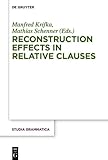Reconstruction Effects in Relative Clauses / ed. by Manfred Krifka, Mathias Schenner.
Material type: TextSeries: Studia grammatica ; 75Publisher: Berlin ; Boston : De Gruyter (A), [2018]Copyright date: ©2019Description: 1 online resource (VI, 453 p.)Content type:
TextSeries: Studia grammatica ; 75Publisher: Berlin ; Boston : De Gruyter (A), [2018]Copyright date: ©2019Description: 1 online resource (VI, 453 p.)Content type: - 9783050062747
- 9783110380774
- 9783050095158
- P297 .R43 2019
- online - DeGruyter
- Issued also in print.
| Item type | Current library | Call number | URL | Status | Notes | Barcode | |
|---|---|---|---|---|---|---|---|
 eBook
eBook
|
Biblioteca "Angelicum" Pont. Univ. S.Tommaso d'Aquino Nuvola online | online - DeGruyter (Browse shelf(Opens below)) | Online access | Not for loan (Accesso limitato) | Accesso per gli utenti autorizzati / Access for authorized users | (dgr)9783050095158 |
Frontmatter -- Contents -- An introduction to reconstruction effects in relative clauses -- A Direct Compositionality approach to Condition C effects under reconstruction and their exceptions -- Relative reconstructions -- A calculus for reconstruction and anti-reconstruction -- Notes on stress reconstruction and syntactic reconstruction -- A new version of the Matching Analysis of relative clauses -- Idioms as evidence for the proper analysis of relative clauses -- Some notes on connectivity and predicational copular sentences -- Functional readings without type-shifted noun phrases -- Deconstructing reconstruction -- Evaluation order, crossover, and reconstruction -- Telescoping by continuations -- Telescoping in relative clauses -- Intensional relative clauses and the semantics of variable objects
restricted access online access with authorization star
http://purl.org/coar/access_right/c_16ec
Reconstruction effects in relative clauses are a class of phenomena where the external head of the relative clause seems to behave as if it occupied a position within the relative clause, as far as some commonly accepted principle of grammar is concerned. An often cited type of example is “The [relative of his] [which every man admires most] is his mother.”, where the pronoun “his” in the relative head appears to be bound by the quantified noun phrase “every man” in the relative clause – although the latter does not c-command the former, which is commonly required for binding. Several solutions have been developed in various theoretical frameworks. One interesting aspect about reconstruction effects in relative clauses is that they can be used as a benchmark for competing theories of grammar: Which architecture of the syntax-semantics interface can provide the most satisfying explanation for these phenomena? This volume brings together researchers working in different frameworks but looking at the same set of empirical facts, enabling the reader to develop their own perspective on the perfect tradeoff between syntax and semantics in a theory of grammar.
Issued also in print.
Mode of access: Internet via World Wide Web.
In English.
Description based on online resource; title from PDF title page (publisher's Web site, viewed 25. Jun 2024)


